| |
| |
Photographer,
Location |
Images |
Comments |
|
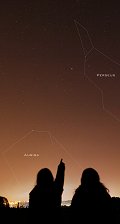
|
Laurent Laveder,
Quimper, Bretagne, France
Oct. 29, 2007 |
#1,
#2, more |
Now that the
diameter of Holmes has increased dramatically, finding it
is a child's play. Tonight, even my daughter and my stepdaughter
know where to find it! Do you need their help?
Photo
details: Canon
30D + Sigma
30mm stop to 2.8 on a tripod. 2 s at 1600 ISO. |
|
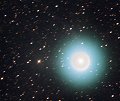
|
Sean
Walker,
Chester, New Hampshire
Oct. 28, 2007 |
#1 |
I
just can't resist a bright comet, even during the brightest
phases of the Moon- I decided to take many short exposures
to try to detect any hint of an Ion tail, rather than concentrating
my efforts on the bright pseudo-nucleus. Success! Note the
faint, diffuse tail trailing off to the upper-left in this
image. 108mm f/4 astrograph, SBIG ST-10XE CCD Camera. 21
minutes of red, green, and blue filtered exposures each.
|
|
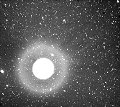
|
Pete Lawrence,
Selsey, West Sussex, UK
Oct. 29, 2007 |
#1 |
This is a 45 minute exposure (9x5 minute exposures) extreme processed to reveal the tail of comet 17P/Holmes. It's extremely faint but is there heading off to the upper right of the coma in this image. As the Moon moves out of the way this should give astrophotographers a better opportunity to focus on the faint structures that constitute that most important piece of a comet - its tail.
|
|

|
Domenico
Licchelli,
Gagliano del Capo, Italy
Oct. 29, 2007 |
#1,
more |
Photo
details: newtonian telescope 300 mm f/5.3 + Canon
400D 1/100 sec at 100 ASA (Moon); 20 sec at 800 ASA
(Comet Holmes) |
|

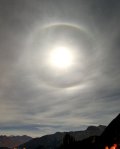
|
Matthieu
Gaudé,
Le Corbier in Savoie departement, France
Oct. 28, 2007 |
#1,
#2, #3,
#4 |
It
was'nt a good night to observe the comet, Moon and cirrus
every where ! But when I turn my eyes to the sky at this
night, a good surprise was waiting for me : a beautifull
atmospheric halo around the Moon, an oval circumscribed
and a parhelic circle and the comet yet!
Photo
details: Canon
350D + Peleng 8 mm / 30s at 800 ISO and Canon 350D +
18-50 F/2.8 |
|
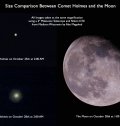
|
Abe
Megahed,
Madison, Wisconsin, USA
Oct. 28, 2007 |
#1,
more |
It
has been interesting to watch the comet change. On one hand,
I'm amazed at how large it has become over the past two
days. It is now assuming more of the look of a comet rather
than a weird planetary nebula and it's neat to see a tail
and some structure emerging. It almost looks like you can
see a "shell" around it from the first eruption. On the
other hand, it has lost some of its beautiful intense yellow
color that gave it such a jewel like quality. I'm glad that
I had a chance to see that on the 25th soon after it first
erupted. In any case, I'm looking forward to watching it
continue to change over the next weeks. -abe. |
|
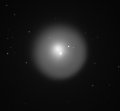
|
Dean
Schwartzenburg,
Nicholasville, KY
Oct. 29, 2007 |
#1 |
65
second exposure (5 x 13 sec) through a Celestron
9.25-inch SCT at f/5 using a Starlight Xpress SXV-H9.
Visually, through a 12-inch scope, the comet looked exactly
like the image! Very high surface brightness even with a
nearby bright moon. |
|

|
Syed Baqir Naqvi,
Quetta, Pakistan
Oct. 28, 2007 |
#1 |
This spectacular comet is zoomed here in this image.
|
|
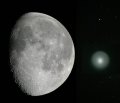
|
Mark van der Hum,
Naarden, The Netherlands
Oct. 29, 2007 |
#1,
#2 |
Comet17P/Holmes
and the moon photographed with the same configuration.
Photo
details: Meade
10" LX-200, 35mm.Panoptic eyepieceprojection. Nikon
coolpix 4500. 8 sec. ISO 400(comet). |
more
images (Oct. 29): from
Adrian Jones of Maidenhead, UK ; from
Masa NAKAMURA of Tochigi, Japan; from
Rijk-Jan Koppejan of Middelburg, The Netherlands; from
Andrew Catsaitis of Central Coast, NSW, Australia.; from
Khosro JafariZadeh of Ahvaz, Iran; from
Giancarlo Cortini and Stefano Moretti of Predappio (Italy);
from
Michael Borman of Evansville, Indiana; from
Scott Conner of Evansville, IN; from
Gary A. Becker of Coopersburg, PA.
|
|